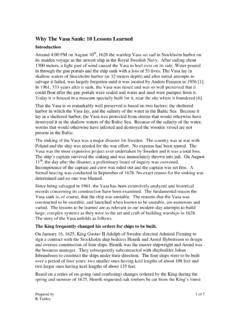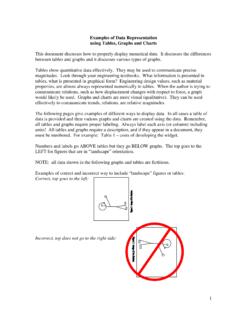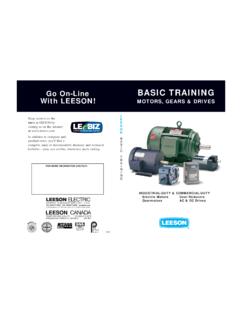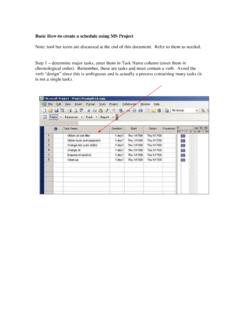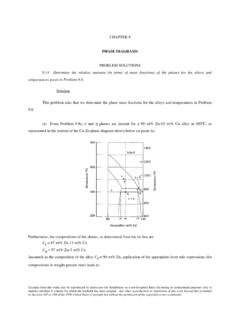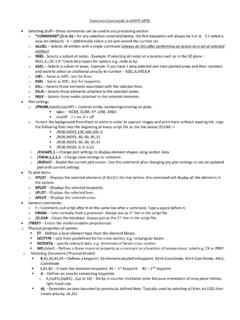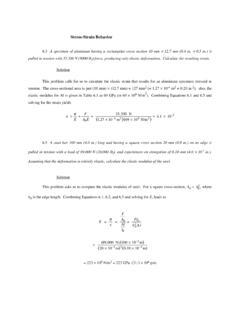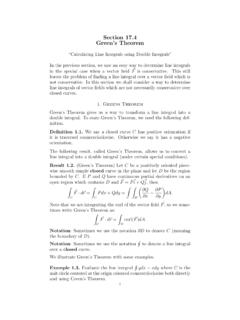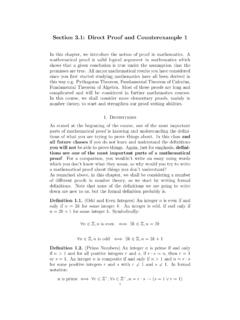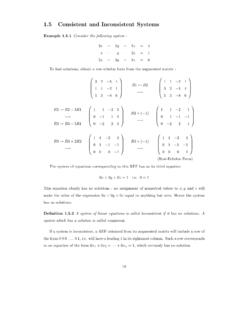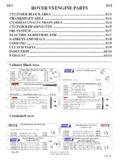Transcription of Section 1.3: Valid and Invalid Arguments
1 Section : Valid and Invalid ArgumentsNow we have developed the basic language of logic, we shall start toconsider how logic can be used to determine whether or not a givenargument is Valid . In order to do this, we shall first formallydefineexactly what we mean by an argument and then discuss differentvalidand Invalid types of argument and how to distinguish Definition of a Valid and Invalid ArgumentWe start with the definition of an argument (form) is a sequence of statements (forms).All statements (forms) in an argument (form) except for the final one,are called premises (or assumptions, or hypothesis).
2 The final state-ment (form) is called the conclusion. The symbol which is read therefore is normally placed just before the we have a formal definition for an argument, we can state whatwe mean by a Valid argument form is Valid if whenever true statementsare substituted in for the statement variables the conclusions is alwaystrue. To say an argument is Invalid means that it is not main point regarding a Valid argument is that it follows from thelogical form itself and has nothing to do with the content. When aconclusion is reached using a Valid argument, we say the conclusion isinferredordeducedfrom the premises.
3 Before we consider examples,we shall briefly examine how one can tell if a given argument form isvalid or test whether or not an argument is Valid , we do thefollowing:(i) Identify the premises and the conclusion(ii) Construct a truth table showing the truth values of the premisesand the conclusion(iii) Look for all the rows where the premises are all true - we callsuch rowscritical rows. If the conclusion is false in a criticalrow, then the argument is Invalid . Otherwise, the argumentis Valid (since the conclusion is always true when the premisesare true).We illustrate with a couple of whether the following Arguments are (i)p qq r p q rConstructing a truth table, we have:p q rp q q rp qp q r T T TTTTTT T FTFTFT F TFTTTT F FFTTF F T TTTTTF T FTFTF F F TTTFT F F FTTFTTo help, we mark the critical rows.
4 Notice that all criticalrows have a true conclusion and thus the argument is Valid .(ii)p qp qp r rConstructing a truth table, we have:p q rp q p q p rrT T TTFTTT T FTFFF T F TTTTTT F FTTFF F T TTTTT F T FTTTFF F TFTTTF F FFTTFTo help, we mark the critical rows. Notice that the 6th rowis a critical row with a false conclusion, so it follows that thethe argument is logic, the words true and Valid have very differentmeanings - truth is talking about the statements making up anargu-ment and validity is talking about whether the conclusion follows fromthe premises.
5 Note that a perfectly Valid argument may have afalseconclusion depending upon the truth value of the premises. Likewise,an Invalid argument may have a true conclusion depending upon thetruth value of the we noted above, the argumentp qq r p q ris a perfectly Valid argument. Letp:= I sleep a lot ,q:= I don tdo any homework andr:= I will do well in this class . Then thistranslates to: If I sleep a lot, then I don t do any homework. If I don t do anyhomework, then I will do well in the class. Therefore, if I sleep a lot ordon t do any homework, I will do well in the class.
6 As noted above, this is a perfectly Valid argument, but clearly not atrue conclusion! This is because though the first hypothesisis true, thesecond hypothesis is false (and hence the conclusion is false - see thetruth table).We finish with one more example of translating an argument into logicalform and then testing the validity of the following argument: Robbery was the motive for the crime only if the victim had moneyin his pockets. But robbery or vengeance was the motive for the , vengeance must have been the motive for the crime. Letp:= robbery was the motive for the crime ,q:= the victim hadmoney in his pockets , andr:= vengeance was the motive for thecrime.
7 Then the argument translates as follows:p qp r rThe truth table is:p q rp q p rr T T TTTT T T FTTFT F TFTTT F FFTF F T TTTTF T FTFF F F TTTTF F FTFFThis is clearly not a Valid argument - as stated above, if the victim hadmoney in their pockets, and the motivation of the crime was robberybut not vengeance, this satisfies all hypothesis, but not theconclusionas suggested by the truth Types of Valid ArgumentWe shall now consider some standard Valid argument forms. A validargument is sometimes called arule of inferencesince the conclusioncan always be inferred from the hypothesis.
8 We shall list thevalidarguments and most of the time we will not prove validity since it isusually fairly obvious. Once they have all been stated, we shall considersome examples of how to use these (Modus Ponens and Modus Tollens) Supposepandqarestatement forms. Then the following are Valid Arguments :(i) The argument calledmodus ponensdefined asp qp q(ii) The argument calledmodus tollensdefined asp q q shall show that modus tollens is qp q q pT TTFFT FFTFF TTFT F FTTTIn this case there is only one critical row to consider, and its truthvalue it true. Hence this is a Valid argument.
9 Result (Generalization) Supposepandqare statement the following Arguments (called generalization) are Valid :p p qq p qResult (Conjunction) Supposepandqare statement forms. Thenthe following argument (called conjunction) is Valid :pq p qResult (Specialization) Supposepandqare statement the following Arguments (called specialization) are Valid :p q pp q q5 Result (Elimination) Supposepandqare statement forms. Thenthe following Arguments (called elimination) are Valid :p q p qp q q pResult (Transitivity) Supposep,qandrare statement the following argument (called transitivity) is Valid :p qq r p rResult (Proof by Division into Cases) Supposep,qandrarestatement forms.
10 Then the following argument (called proofby divisioninto cases) is Valid :p qp rq r rResult (Contradiction) Supposepis statement form and letcdenote a contradiction. Then the following argument (called proof bycontradiction) is Valid : p c pThat is, if you can show that the hypothesis thatpis false leads to acontradiction, thenphas to be truth table for this argument is as follows:p c p cp T FTTF FFFThis is a Valid argument - there is only one critical row and this rowhas a positive truth value. Before we consider some examples, we make a few remarks abouttheserules of inference: The names of the rules of inference we have described aboveusually describe exactly what the rule of inference does.
